
Genuine Cadmium colours are beloved by artists for their characteristic high lightfastness, opacity, colour strength and brilliance since the beginning of the 20th century. In 1817, whilst studying compounds of Zinc carbonate, German chemist, Friedrich Stromeyer, discovered the element Cadmium, which is a common impurity of zinc compounds, though often found only in minute quantities. The synthetic inorganic pigment Cadmium Yellow was commercially introduced in mid-19th Century when Artists like Claude Monet began to use the Cadmium pigment for the yellow in his paintings, but it was not until early 20th century when Cadmium Red and Orange was available commercially.
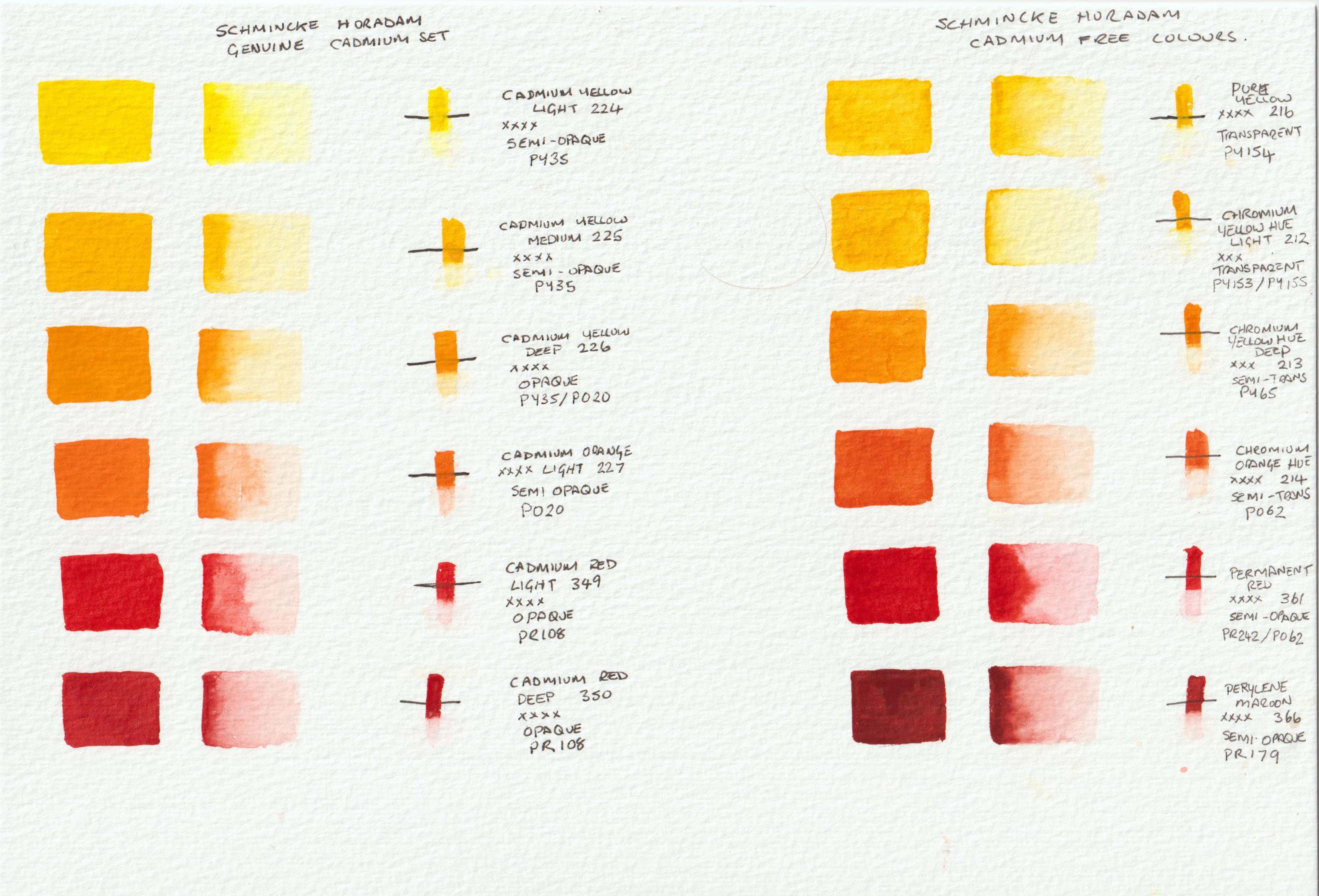
The Schmincke Horadam Aquarell watercolour paints have been manufactured since 1818 using high quality natural gums and quality pigments. They offer alternative and comparison sets, each containing six popular colours from the yellow-orange-red range in 5ml tubes, one has the pure cadmium colours, the other has the simulated cadmium-free alternatives. The colouristically similar, cadmium-free colours are based on different, purely organic pigments and have different lightfastness and covering properties (transparent to semi-transparent).
The set “Genuine Cadmiums” contains the following Horadam watercolours 224, 225, 226, 227, 349 and 350.
The set “Cadmium-Free Colours” contains the following Horadam watercolours 216, 212, 213, 214, 361 and 366.
As Cadmiums are reds, yellow and Oranges a good test is to add a blue into the mix to see how well the colour mix.
Using French Ultramarine, a classic blue on any palette you can see how well the Cadmium colours and the alternative colours mix with a blue. This is where you can either discover the differences in the colours or be pleasantly surprised that there is little difference.
Genuine Cadmium Colours
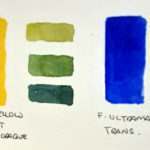 Cadmium Yellow Light 224
Cadmium Yellow Light 224
**** Extremely Permanent
Semi Opaque
PY35 (Cadmium Zinc Sulphide)
 Cadmium Yellow Medium 225
Cadmium Yellow Medium 225
**** Extremely Permanent
Semi Opaque
PY35 (Cadmium Zinc Sulphide)
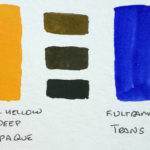 Cadmium Yellow Deep 226
Cadmium Yellow Deep 226
**** Extremely Permanent
Opaque
PY35/PO20 (Cadmium Zinc Sulphide / Cadmium Sulfoselenide)
 Cadmium Orange Light 227
Cadmium Orange Light 227
**** Extremely Permanent
Semi Opaque
PO20 (Cadmium Sulfoselenide)
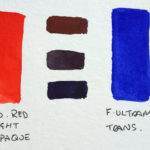 Cadmium Red Light 349
Cadmium Red Light 349
**** Extremely Permanent
Opaque
PR108 (Cadmium Sulphoselenide)
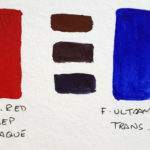 Cadmium Red Deep 350
Cadmium Red Deep 350
**** Extremely Permanent
Opaque
PR108 (Cadmium Sulphoselenide)
Cadmium-Free Colours
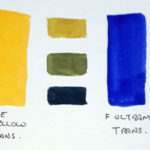 Pure Yellow 216
Pure Yellow 216
**** Extremely Permanent
Transparent
PY154 (Benzimidazolone Yellow)
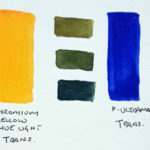 Chromium Yellow Hue Light 212
Chromium Yellow Hue Light 212
*** Permanent
Transparent
PY153/PY155 (Nickel Dioxine Yellow/ Biasacetoacetarylide Yellow)
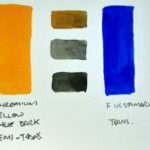 Chromium Yellow Hue Deep 213
Chromium Yellow Hue Deep 213
*** Permanent
Semi- Transparent
PY65 (Hansa Yellow Deep)
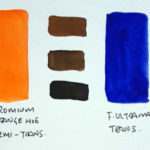 Chromium Orange Hue 214
Chromium Orange Hue 214
**** Extremely Permanent
Semi-Transparent
PO62 (Benzimidazolone Orange)
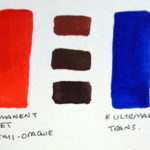 Permanent Red 361
Permanent Red 361
**** Extremely Permanent
Semi-Opaque
PR242/PO62 (Disazo Condensation Scarlet/Benzimidazolne Orange)
 Perylene Maroon 366
Perylene Maroon 366
**** Extremely Permanent
Semi-Opaque
PR179 (Perylene Maroon)
Colour mixing seems a little tedious when you look at it but when you get going and start to discover all the possibilities of the colours then it becomes a necessity and a wonder, as even as an experienced artist you are astonished with how many other colours can be achieved from just two colours and how just adding a touch more of one can really alter the mix .
It is a very satisfying feeling to do a colour chart as you see how the different pigment react with each other like:
Opaque plus Transparent – This will make the transparent colour more opaque, increasing the covering power
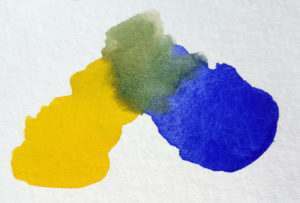 Transparent plus Transparent – transparent colour allows the bright freshness of the white paper to glow through and mixing two transparent colours will mean that these colours will create a transparent mix and can be a little brighter than an opaque mix as the white of the paper adds to the effect.
Transparent plus Transparent – transparent colour allows the bright freshness of the white paper to glow through and mixing two transparent colours will mean that these colours will create a transparent mix and can be a little brighter than an opaque mix as the white of the paper adds to the effect.
Granulating with Non-Granulating – a granulating colour like French Ultramarine can create some wonderful texture depending on the colour it is mixed with. In this case the French Ultramarine and the Cad Yellow Light and Cad Yellow Medium created an exciting granulating green.
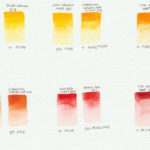 It has been a useful and rewarding exercise to be able to compare the two sets of Schmincke Horadam Aquarelle 5ml tubes.
It has been a useful and rewarding exercise to be able to compare the two sets of Schmincke Horadam Aquarelle 5ml tubes.
After the colour swatches of both sets were completed, the colours are a very close match which is good and the mixes are very similar. The Cadmium colours are still that little bit brighter and more opaque but on the whole it is fun and interesting to be able to see the differences and have the option of a different paint which colouristically works like the Cadmium colours.